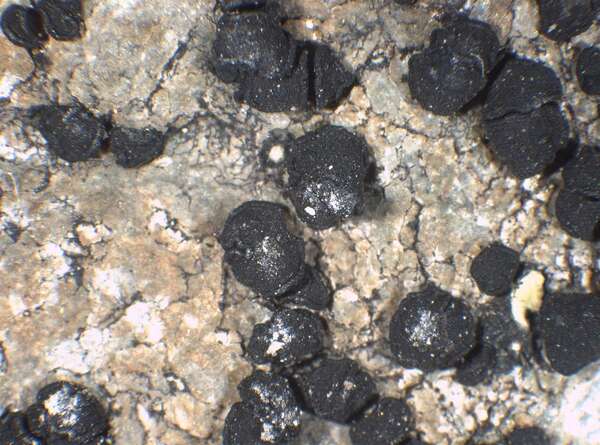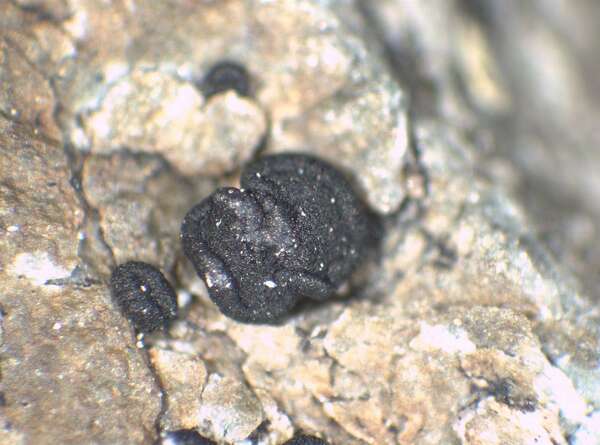Buellia vilis Th. Fr.
K. Svensk. Vetensk.-Akad. Handl., Ny folj. 7, 2: 44, 1867.
Synonyms: Buellia enteroleucoides (Nyl.) Arnold; Buellia modica (Nyl.) Migula; Lecidea enteroleucoides (Nyl.) Nyl.; Lecidea modica Nyl.
Description: Thallus crustose, endosubstratic to very thinly episubstratic, poorly evident, the hyphae strongly amyloid, I+ blue. Apothecia lecideine, 0.2-0.7(-1) mm across, sessile, constricted at base, with a flat to slightly convex disc, and a thick, persistent proper margin. Proper exciple Vilis-type, radially composed of textura oblita, up to 60 µm wide, the outer part brown-red to black, K-, N+ intensifying purple, the inner part colourless and strongly I+ blue; epithecium brown; hymenium colourless, without oil droplets, c. 80 µm high; hypothecium colourless, strongly amyloid. Asci 8-spored, clavate to cylindrical-clavate, the apical dome K/I+ dark blue with a pale, conical-pointed apical cushion (axial mass), the wall I-, but the thin outer gel I+ blue, Bacidia-type. Ascospores 1-septate, brown, broadly ellipsoid, slightly constricted at septum, 12-15(-18) x (6-)7.5-9 µm, Buellia-type, with a smooth to microrugulate wall. Pycnidia black, sessile. Conidia bacilliform, (2.5-)4-6(-7) µm long. Photobiont chlorococcoid. Spot tests: K-, C-, KC-, P-, UV-. Chemistry: without lichen substances.
Growth form: Crustose
Substrata: rocks
Photobiont: green algae other than Trentepohlia
Reproductive strategy: mainly sexual
Pioneer species
Commonnes-rarity: (info)
Alpine belt: rare
Subalpine belt: very rare
Montane belt: extremely rare
Dry submediterranean belt: absent
Humid submediterranean belt: absent
Padanian area: absent
pH of the substrata:
1 2 3 4 5
Solar irradiation:
1 2 3 4 5
Aridity:
1 2 3 4 5
Eutrophication:
1 2 3 4 5
Poleotolerance:
0 1 2 3
Altitudinal distribution:
1 2 3 4 5 6
Rarity
absent
extremely rare
very rare
rare
rather rare
rather common
common
very common
extremely common
Loading data...
Occurrence data
Predictive map
Growth form: Crustose
Substrata: rocks
Photobiont: green algae other than Trentepohlia
Reproductive strategy: mainly sexual
Pioneer species
Commonnes-rarity: (info)
Alpine belt: rare
Subalpine belt: very rare
Montane belt: extremely rare
Dry submediterranean belt: absent
Humid submediterranean belt: absent
Padanian area: absent
pH of the substrata:
| 1 | 2 | 3 | 4 | 5 |
Solar irradiation:
| 1 | 2 | 3 | 4 | 5 |
Aridity:
| 1 | 2 | 3 | 4 | 5 |
Eutrophication:
| 1 | 2 | 3 | 4 | 5 |
Poleotolerance:
| 0 | 1 | 2 | 3 |
Altitudinal distribution:
| 1 | 2 | 3 | 4 | 5 | 6 |
Rarity
absent
extremely rare
very rare
rare
rather rare
rather common
common
very common
extremely common
Loading data...
Occurrence data
Predictive map








